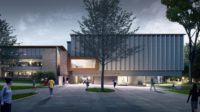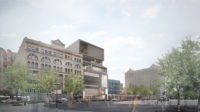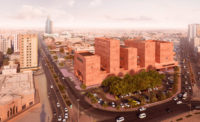Adjaye Associates Unveils Plans for Edo Museum of West African Art

View of main entrance and courtyard garden, rendering © Adjaye Associates

Ground floor, image © Adjaye Associates

First floor, image © Adjaye Associates

Roof plan, image © Adjaye Associates

Long section, image © Adjaye Associates

Short section, image © Adjaye Associates






Architects & Firms
Adjaye Associates, along with the Legacy Restoration Trust of Nigeria and the British Museum, has unveiled plans and renderings for the Edo Museum of West African Art (EMOWAA), a project formerly known as the Benin Royal Museum. Sited next to Oba’s Palace in Benin City, Nigeria, the new museum is a catalyst in a three-pronged effort: to create a home and interpretive center for the art and artifacts of Benin’s heritage; to engage in archeological work in the ancient royal city, on the museum site; and to push for the restitution of countless objects looted during the colonial period, now housed in institutions across the U.K, Europe, and North America. Among the most famous of these artworks are Benin bronzes—cast sculptures and plaques with reliefs, many from the kingdom’s palace—of which the British Museum has 900 in its collection.

The elegant bronzes (often composed, actually, of another metal or alloy) date from as early as the 13th century and probably became known to Europeans through the Portuguese, who began trading along the West African coast in the 15th century. But the most destructive single event in the wholesale scattering of the bronzes and other historical artifacts around the world was the brutal sacking and razing of the royal city of Benin by the British in 1897.
The design of Adjaye’s museum and its surrounding landscape will seek to incorporate those ruins—surviving fragments of walls, moats or gates—in what a press release calls “the most extensive archeological excavation ever undertaken in Benin.” So far, $4 million has been raised for funding the dig.

Some of the fragments may inspire the forms of the museum’s gallery pavilions that could “allow the objects themselves to be arranged in their pre-colonial context,” says the press release. Adjaye calls his scheme “a new museum paradigm for Africa … undoing the objectification that has happened in the West,” and creating “a place for recalling lost collective memories of the past.” The Ghanaian-British RIBA Gold–winning architect, whose firm has offices in London and New York, is now based in an office in Accra—a move he discussed last month in his keynote presentation at Architectural Record’s 2020 Innovation Conference. (Register here to watch a recording of the session.)

The plans for the museum will doubtless further pressure Western institutions to return Benin’s patrimony—though most are not committing to permanently giving back looted pieces but lending them. Last month, the French Parliament voted overwhelmingly to return two dozen stolen objects to Benin and a sword and scabbard to Senegal—though that represents a miniscule part of the 90,000 works the country holds from all over Africa. Digital Benin (digitalbenin.org) is a project to document and catalogue objects from the country in collections all over the globe.











